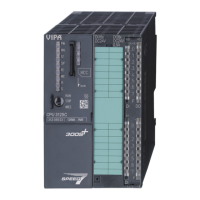n After a request from the master, this waits for a preset delay time
for an answer of the slave. During the delay time, communication
with other slaves is not possible.
n After a send command, the acknowledgement telegram must be
read by a call of the FC/SFC 218 SER_RCV.
n The request telegrams send by the master and the respond tele-
grams of a slave have the following structure:
Telegram structure
Start sign Slave
address
Function
Code
Data Flow control End sign
n A request can be directed to a special slave or at all slaves as
broadcast message.
n To mark a broadcast message, the slave address 0 is used.
n In opposite to a "normal" send command, the broadcast does not
require a telegram evaluation via FC/SFC 218 SER_RCV.
n Only write commands may be sent as broadcast.
Modbus offers 2 different transfer modes. The mode selection hap-
pens during runtime by using the FC/SFC 216 SER_CFG.
n ASCII mode: Every byte is transferred in the 2 sign ASCII code.
The data are marked with a start and an end sign. This causes a
transparent but slow transfer.
n RTU mode: Every byte is transferred as one character. This ena-
bles a higher data pass through as the ASCII mode. Instead of
start and end sign, a time control is used.
The following Modbus Protocols are supported by the RS485 inter-
face:
n Modbus RTU Master
n Modbus ASCII Master
7.7 Modbus - Function codes
Modbus has some naming conventions:
n Modbus differentiates between bit and word access; bits = "Coils"
and words = "Register".
n Bit inputs are referred to as "Input-Status" and bit outputs as "Coil-
Status".
n word inputs are referred to as "Input-Register" and word outputs
as "Holding-Register".
Broadcast with slave
address = 0
ASCII, RTU mode
Supported Modbus pro-
tocols
Naming convention
VIPA System 300SDeployment PtP communication
Modbus - Function codes
HB140 | CPU-SC | 312-5BE13 | GB | 15-50 158

